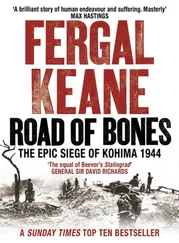Another British visitor was RAF Sergeant Fred Hill who spent a week living among the Naga as part of a survival course. Hill’s memories are not those of an anthropologist or a politician but of a working-class boy from Birmingham entranced by an alien world. From the Nagas he learned how water could be found in bamboo stalks and how to watch what the monkeys ate because ‘whatever they eat you can eat because if it kills the monkeys then it will kill you’. But he also recorded the deaths of Nagas from food poisoning as a result of eating rotting rations abandoned by the British. ‘Civilisation was no good to them, not our type of civilisation.’
Charles Pawsey saw his mission as one of protection. To achieve this he enforced the doctrine of Naga separateness laid down by the Raj. Visitors to the Naga Hills had to have a permit, and these were given out sparingly. Except in isolated cases, the planting of land for commercial purposes was forbidden. The same prohibition applied to private industry, with a handful of exceptions. Within the constraints of the imperial imagination this policy was benign and it ensured relative peace in the region, but its effect was to preserve Naga life in a political vacuum. As one Indian writer has put it, ‘Any observer of the North-East Indian situation may conclude that the tribal people there were purposely kept in isolation from the Indian nationhood.’ The logic of Naga separateness, codified under imperial rule, was to have devastating consequences when the Raj retreated.
Pawsey, like so many other servants of the Raj, could hardly have foreseen what war and the rising tide of nationalism would do to this world within a very short space of time. But the Japanese conquests in 1941–42 had an electrifying effect in India. By the summer of 1942 Gandhi and his supporters in the Congress Party had launched the Quit India campaign, demanding an immediate British withdrawal. * In the tea country of Assam next to the Naga Hills there were anti-British protests. In September 1942 thirteen people were shot dead in demonstrations at police stations. The following month Congress activists derailed a train carrying British troops into Assam, causing several deaths and widespread injuries. A militant was hanged and many others were sentenced to long prison terms. British troops arriving in India that year cound find themselves confronting angry crowds. Captain Gordon Graham of the Cameron Highlanders arrived with the British 2nd Division in June 1942 and recalled asking a Sikh man for directions to the police station: ‘My friend,’ the Sikh told him, ‘you will learn that the police in India are not here to help people. And neither are you.’
But among the Naga population, mistrustful of the Indians from the plains, there was negligible support for the Congress protests. If anything, Naga opinion had been radicalised in support of the British by the behaviour of some Indian troops retreating through the Naga Hills from Burma earlier in 1942. Rape and looting were reported from several areas as gangs of deserters moved towards Assam. To the Nagas, Charles Pawsey and his colonial administration seemed a far safer bet than the unknown quantity of an Indian liberation movement.
Still, the world of genteel drinks parties at Pawsey’s bungalow, of long treks into the interior by visiting anthropologists and botanists, of illiterate tribesmen living by the fiat of British officials, was slipping towards its twilight. Its last hurrah would be glorious and tragic, a drama of war that was both modern and inescapably Victorian, replete with outnumbered garrison, fanatical enemy, heroic last stands, and a cast of characters whose diversity and eccentricity belonged to the age of high empire.
*The Indian Tea Association (ITA) established a ‘Refugee Organisation’ to help deal with the influx of people into Assam. It was an early example of a civilian administered aid effort that would become so common in the later years of the 20th century.
*The Treaty of Yandaboo was signed in February 1826 and brought to an end the First Anglo-Burmese War. The treaty was a humiliation for the Burmese monarchy, which lost control over vast tracts of territory. Fifteen thousand British and Indian troops died in the war and many more on the Burmese side.
†Sir Cecil Beadon (1816–80) was criticised in an official report and in the House of Commons for his administrative failures during the Bengal famine of 1866–67 and ended his career in ignominy. He also told a House of Commons committee on the opium trade that the government was motivated solely by considerations of revenue, and that it would ‘probably not’ be moved by concerns about the ill effects of opium on those who bought it. Frederick Storrs Turner, British Opium Policy and its Results to India and China (Low, Marston, Searle & Rivington, 1876), p. 256.
*This loyalty lasted only until 1891 when palace intrigues deposed the maharajah and installed a regent. On arriving to punish the usurper, the British were greeted by a band playing ‘God Save the Queen’. After a good dinner at the residency the British retired to bed, and were promptly attacked and their forces routed. NA, WO 32/8400, Proceedings of the Court of Inquiry assembled at Manipur on the 30th April 1891 and following days to investigate the circumstances connected with recent events in Manipur.
*Rani Gaidiliu survived the Second World War and was declared an honoured freedom fighter by the government of Jawaharlal Nehru. She went underground again in the 1960s when she led her followers against the dominant Naga political group in a brief civil war.
*The Quit India campaign was launched on 8 August 1942 after the failure of the mission by Sir Stafford Cripps to persuade Congress to support the war in return for a gradual devolution of power and the promise of dominion status. Gandhi called for immediate independence and was immediately arrested along with Nehru and the rest of the senior leadership of Congress, who would spend the next three years of the war in jail. There were an estimated 100,000 arrests and several hundred deaths in the rioting and crackdown that followed. By March 1943 the campaign had been suppressed, although the British had to devote fifty-seven battalions to maintaining internal security. The British official history of the war estimated that the training of a number of army formations and reinforcements was set back by up to two months and ‘there was a general loss of production in all factories turning out arms, clothing and equipment’. S. Woodburn Kirby, The War Against Japan , vol. 2: India’s Most Dangerous Hour (HMSO, 1958), p. 247.
FOUR
The King Emperor’s Spear
On their way to Kohima from Burma, refugees would occasionally encounter Japanese units. They were not prevented from leaving Burma by the patrols and were usually able to carry the news of their encounters to Pawsey and the tea-planters who were organizing the relief effort. ‘Some of them gave us the grim information,’ wrote a planter, ‘that the Japs did not intend to bomb the road too badly as they looked forward to making full use of it themselves.’ The British and Indian forces were in no state to face a serious Japanese offensive. The 1st Glosters were stationed in Kohima as part of 17th Indian Division from August 1942 but were still suffering the effects of the retreat. As well as sick and wounded, a high proportion of troops were on leave. The battalion had left most of its equipment behind in Burma and supplies of food were short because of transport problems. As Captain H. L. T. Radice recalled, the road was constantly disintegrating because of heavy rain. ‘As a result, the battalion was on half rations.’ A Japanese reconnaissance plane came over frequently, but to the intense relief of the Kohima garrison it was never followed up by an air raid. As the refugees left, the village returned to its usual function as supply depot, a convalescent centre for sick and wounded troops, and the administrative headquarters of the Raj in the Naga Hills. Soon the officers were enjoying a social life once more. Lieutenant Dennis Dawson of the Royal Indian Army Service Corps described a bucolic existence: ‘It [was] a lovely place, a sleepy place. We had parties. There were three hospitals. Plenty of nurses and we thought “well this is a lovely life up here”.’
Читать дальше












